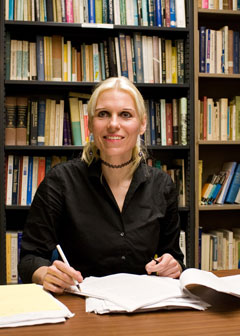The pandemic has spread its misery for months, enveloping us in “a season of darkness” as Charles Dickens described in his classic opening to A Tale of Two Cities. Yet, we’ve likewise witnessed a “spring of hope”—embodied in the untold acts of courage and compassion that aim to ease the suffering of others during these challenging times.
Through a range of teaching and learning experiences, University of Miami faculty members across different disciplines are cultivating empathy and exploring how the capacity to express compassion for others enhances our own sense of well-being and self-worth.
“The fascinating thing about altruistic behavior is that we benefit tremendously from it in terms of our own well-being,” said Adam Carrico, a professor of public health sciences and psychology. “Through our ability to help someone, we feel good about ourselves, about the world, and our place in it.”

Carrico, also the director of the Division of Preventive Science and Community Health, is guiding two randomized controlled trials that test the efficacy of positive emotion intervention to optimize HIV/AIDS prevention in minority men who are sexually active. Half of the participants who are managing chronic stress related to HIV/AIDS, their sexual minority status, and using stimulants such as methamphetamine receive a positive emotion intervention. One of the skills delivered in the intervention encourages men to practice small acts of kindness and other altruistic behaviors such as volunteerism in order to stimulate positive emotions, foster a better self-image, and reframe their current circumstances and stressors.
“In our trials, the hope is that empathy can be built behaviorally,” Carrico added. “And it’s part of how we teach it. Practicing empathy is good for other people, and it’s good for you in terms or your own well-being.”
Teaching empathy through literature
Berit Brogaard, a professor in the philosophy department, and Aleksandra Hernandez, a postdoctoral associate in the English department, co-taught a course last spring titled, “Aesthetics: Literature and the Emotions,” that explored how to use literature to cultivate empathy, among other topics.

“Literature allows us to gain insight into a character whose experience is different from ours—it is a vehicle for understanding other points of view,” Hernandez explained. “Particularly when characters are part of cultural contexts that are different from ours, there is the sense that some negotiation of difference is needed to arrive at a better, if incomplete, understanding of the character’s situation.”
Yet reading alone is not enough, Hernandez explained, pointing to the findings of researchers such as Suzanne Keen and others who are exploring the role educators and mentors play in modelling reading practices that stimulate empathy and understanding.
“You need a guide who can help your understanding of the multiple dimensions, all these different layers and contexts of a complex piece of literature—this requires the involvement of a teacher,” she said.
Brogaard and Hernandez are also using literature to cultivate empathy through their civic engagement efforts as part of an Engaged Faculty Fellowship at the University of Miami. The project is paused because of the pandemic, yet when it resumes, students will develop group projects in collaboration with teachers and students at Miami high schools in underserved neighborhoods. Age-appropriate literature structured around empathy will stimulate class discussions and allow students to see beyond their own biases and experiences.

Brogaard echoed the essential need for an able facilitator or teacher to catalyze and deepen the learning that leads to empathy.
“The fellowship projects certainly involve teaching,” she said. “Our students will be interacting with students of the same age and yet very different from themselves. It’s really a way that can help you develop a better understanding of another social identity group.”
This ability to better understand and appreciate another group—be it a difference of class, ability, gender, racial or ethnic identity—begs for empathy, and Hernandez emphasized the need for teacher diversity, those in positions to guide the discussions and conversations.
“We all have our blind spots,” she said, such as “a student that might come to college on a sports scholarship and didn’t have a good high school education, and who might not perform as well as other students. If the teacher doesn’t recognize that they don’t have the needed background and the technological resources to succeed, they will be failing the student. We need diversity among the faculty members, more inclusivity and understanding to address these biases.”
Differing components of empathy
The two scholars differentiate between emotional empathy, feeling someone else’s joy or sufferings, from cognitive empathy, involving, for example, reading facial expressions and social cues to predict behaviors and imagine how someone might react. They are also currently exploring a third distinct component.
“With emotional empathy, you literally might feel the suffering by experiencing physiological changes in your body. For example, your stomach could be hurting,” Brogaard explained.
Cognitive or intellectual empathy doesn’t necessarily give rise to any changes in the body, she explained, it may simply manifest itself as a concern about something or someone. This concern, such as trying to understand what it’s like to be Black, disabled, or part of some other marginalized group if you’re not, may encourage you to take action and promote social change.
“When seeking to cultivate empathy in a situation like this, you can only gain a partial understanding of where the issue lies. If you don’t acknowledge someone’s difference of experience, you not only risk offending them, but you also erase essential aspects of their social experience that might have otherwise informed how you go about addressing systemic injustice,” Hernandez said.
“This type of empathy is clearly not an emotion; it has to go beyond mere feeling,” Brogaard said, in qualifying the new empathy distinction. “Feeling bad about a Black person’s mistreatment, for example, doesn’t by itself give you insight into the Black experience in the U.S. today. To enhance your understanding, you would also need to acquire a substantial amount of knowledge of Black history and Black literature, and interact with Black people, listen to their stories and their first-person perspectives.”
Factors that block empathy
“Almost everyone seems to have the ability to feel or understand what someone else might be feeling,” Carrico explained. However, factors both past and present may inhibit the expression of this basic tendency. Adverse childhood experiences—neglect, abuse, and other traumas—can serve as obstacles to seeing the benefit of selfless acts, disconnecting us from our ability to be in the present moment and showing compassion for others.
He also pointed to “biological vulnerabilities,” both genetic and even epi-genetic—such as the epigenetic legacy of traumas that cross generations—that could partially explain dysfunctional patterns.
“It’s not that someone is born to have antisocial personality, it’s a combination of the person and their environment, including their development,” Carrico said. “Not only is the lack of empathy in some individuals problematic for society, but it is very detrimental to the people who experience difficulties feeling what others might—who seem to view every human exchange as transactional with no meaningful connections to others.”
Carrico’s efforts and those of Brogaard and Hernandez point to the importance of exercising the strength of empathy.
“The exciting part of it is that there are modifiable factors, it’s not just biology equals destiny,” Carrico said. “Empathy is shaped by the complex interplay of the person and the environment, and there are certainly ways we can design environments to provide positive reinforcement for empathic responding as well as to build social networks that model and support empathy,” he added.
“And while we often view empathy and altruism as selfless acts, there are also tremendous benefits to the individuals that perform them,” he said.

